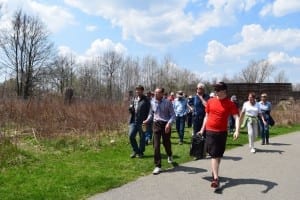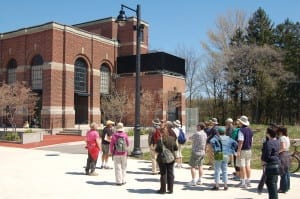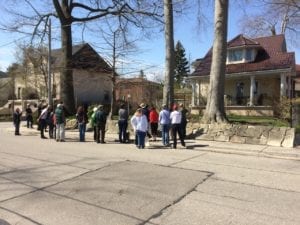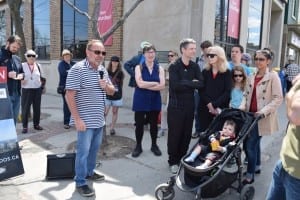Revisiting the Jane’s Walk principles in 2021: Text from Jane’s Walk website, to which I’ve added commentary
Click here for previous posts about Jane’s Walk >
Click here to access the following text at the Jane’s Walk website >
The following text is from Jane’s Walk.
Revisiting the Jane’s Walk principles in 2021
2020 was relentless and imperative. With events ranging from a global pandemic to global Black Lives Matter protests, we, the Jane’s Walk Steering Committee, like many others, began to engage in critical self-reflection and demand action of ourselves.
Jane Jacobs’ friends started Jane’s Walk following her death in 2006, and in its early days, they created a list of principles the organization would follow.
Drafting the first principles was an important activity, as they referenced many key ideas of Jane herself. Nearly 15 years later, the ideas of Jane Jacobs continue to inspire city planners, designers, policy advocates and activists. And because of her insights, thousands of people around the world find their way to Jane’s Walk.
As the Jane’s Walk movement grew, the world around it evolved. The nature of city building and the related political discourse around who gets to speak, about what, and for what purpose, were all important to Jane and remain important today. Now, in 2021, where it is more crucial than ever to engage in the critical reflection of ideas, we acknowledge the necessity to engage in critical reflection of the role Jane’s Walk plays and the responsibility it has in contributing to a city’s story.
With that said, the Steering Committee has revisited the Jane’s Walk principles first developed 15 years ago. We have done so in an effort to be thoughtful about our offering and what it contributes to the discipline of city building. You can view our revised principles here. We invite you to read through them, critique them, and share your thoughts with us by email and/or through this survey. Jane’s Walk is powered by the communities in which it operates, and we hope the same can be true of our principles.
*
Jane’s Walk is a movement of free, citizen-led walking conversations inspired by Jane Jacobs. It encourages people to share stories about their neighbourhoods, discover unseen aspects of their communities, and use walking as a way to connect with their neighbours.
[End of text]

Walking south along Waterfront Trail during May 3, 2015 Jane’s Walk in Mississauga led by City of Mississauga Ward One Councillor Jim Tovey. A wooden baffle from the Long Branch Rifle Range, dating back from the 1890s, is visible in the background. Jaan Pill photo
Commentary
A previous post is entitled:
An excerpt from the above-mentioned post notes that I do not know what a Jane’s Walk is, as I’ve remarked previously:
Here are a few thoughts that occur to me. First, how Jane’s Walk was set up in the first place is of interest. Based on a few conversations years ago, I have the sense (based on anecdotal evidence from such conversations) that the original concept for the walks was quite tightly structured. However, early on, as I understand, the structure was opened up: anybody who wanted to, could organize a walk.
That is, things were not going to be tightly controlled by the originators of the concept. A walk can be a walking lecture, or a walking conversation, or a combination of both of these approaches, as the case may be.

A May 4, 2013 Jane’s Walk in Long Branch included a visit to the Power Plant in New Toronto at the Lakeshore Hospital Grounds. The building, located south of the Assembly Hall, serves as a dressing room for skaters at the Colonel Samuel Smith Ice Trail during the winter months. Gay Chisholm photo
I have an interest in the origins of community self-organizing efforts of all kinds. For that reason, I’m really pleased that I’ve been able to learn, from such conversations, about the early history of Jane’s Walk.
I’ve often noted, in talking about Jane’s Walk, that I really don’t know what a Jane’s Walk is. That’s what I like, as I’ve often said at this website, about Jane’s Walk: the lack of clarity regarding what it is.
‘Seeing like a state’ qualifies as a highly suspect way of seeing
I’ve written extensively about the worldview that the anthropologist and political scientist James C. Scott brings to his analysis of concepts such as ‘seeing like a state,’ and to his analysis of how city states first emerged in history. His approach to the study of large-scale projects of all kinds is inspiring, from my vantage point.

May 5, 2018 Jane’s Walk stops to admire a Cottage Era house at the corner of Long Branch Ave. and Muskoka Ave. Jaan Pill photo
A subtext in his observations is that a lack of clarity, and a lack of huge ambition regarding what can be done by way of ‘clarifying things,’ is commendable, in contrast to the practice of ‘seeing like a state,’ where humans are subjected to social engineering of all kinds, and nature is subjected to large-scale (and, as it happens, invariably disastrous) physical engineering feats and efforts.
James C. Scott offers many case studies to underline his point, regarding the drawbacks of ‘seeing like a state.’ To the case studies he has cited I would add a first-rate study, namely Stasiland (2002) by Anna Funder which I have recently read with much interest.
A corollary is that sometimes, the only way to establish a useful perspective, regarding a given situation, is to look at it strictly at a local level. An additional corollary is that what applies at a given local level will not, necessarily, apply elsewhere. To state the matter in another way, general principles are at times suspect.
Hayley Goodchild dissertation
I’ve also mentioned that I am very much impressed with a 2017 PhD dissertation by Hayley Goodchild regarding the history of the Ontario dairy industry from the 1860s to the 1930s. I’ve mentioned the thesis in an article about local history in Stratford, Ontario:

New Toronto – Then and Now, At May 2, 2915 Jane’s Walk, Mike James shares his recollections of his teenage years in New Toronto. The other walk leader, Brian Liberty, is visible at the left of the frame. Jaan Pill photo
The thesis mentions a study or studies by James C. Scott. A key conclusion of the Hayley Goodchild dissertation is that the attempt to ‘reform’ the Ontario dairy industry by building cheese factories starting in the 1860s to supply the British demand for cheese ran into a particular problem. That problem was that the reformers were keen to manage nature but nature wasn’t amenable.
As James C. Scott has underlined, nature does not respond well to being managed. Among other things, as both Scott and Goodchild underline, because humans don’t have sufficient understanding or comprehension of nature, attempts to manage nature – including human nature – on a large scale are not going to work as expected. Unintended consequences will arise instead.
I encourage you to fill out the Jane’s Walk survey mentioned earlier at this post. For any project, organization, or enterprise, taking close account of ongoing and regular input from a wide and diverse range of people, such as through well-designed surveys (or, say, open-ended ‘walking conversations’), is most useful and commendable.

Leave a Reply
Want to join the discussion?Feel free to contribute!